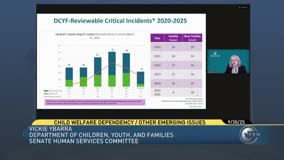DCYF data show spike in reviewable child fatalities and near‑fatalities tied to opioids; agency rolls out targeted practices
September 30, 2025 | Legislative Sessions, Washington
This article was created by AI summarizing key points discussed. AI makes mistakes, so for full details and context, please refer to the video of the full meeting. Please report any errors so we can fix them. Report an error »

Vicky Ybarra, DCYF’s assistant secretary for Partnerships, Prevention and Services, told the Senate Human Services Committee that reviewable critical incidents—child fatalities or near‑fatalities with recent child‑welfare involvement—rose substantially in 2022–2024 and produced a concerning early‑2025 spike. Ybarra said the department’s statutory reviews show the increase tracks closely with opioid and fentanyl trends reported by emergency medical services (EMS) data.
Ybarra gave committee members a timeline of entries to out‑of‑home care: entries fell from about 3,300 in 2023 to about 2,800 in 2024 after 12/27’s removal standard took effect, then rose again to roughly 3,200 after SB 6109 (the fentanyl‑response law) was implemented. She said the state saw 22 DCYF reviewable critical incidents in the first quarter of 2025, compared with nine in the first quarter of 2024; about 68% of the 2025 quarter‑one critical incidents were opioid‑related, Ybarra said.
Ybarra described the department’s short‑term and statewide responses. Immediate actions after the early‑2025 spike included:
- Implementing “safe child consult,” a statewide case staffing practice for every case involving opioid use and a child under age 3.
- Deploying regional legal liaisons (authorized by SB 6109) to support caseworker court preparedness.
- Gathering frontline staff expertise through statewide hypothesis‑gathering sessions to identify operational best practices.
- Monitoring geographic hotspots (the early spike was driven largely by cases in the Spokane area) and informing contractors and community partners about same‑day treatment and referral options.
Ybarra said some SB 6109‑authorized contracted services were not implemented after revenue shortfalls and a temporary freeze; the department has submitted a decision package to restore many of those strategies. She also said the department planned a legislative briefing in early November to release updated critical‑incident numbers that incorporate quarter‑2 and quarter‑3 information.
Committee members asked for additional disaggregated data, including age breakdowns for the 0–3 group and geographic hotspot maps; Ybarra agreed to follow up. She emphasized that although critical incidents represent a small percentage of all children involved with child welfare (DCYF estimated the group at about 0.2% of the total child‑welfare population), the increases signal systemic stressors that require preventive community services, inpatient and outpatient treatment capacity, housing and other supports.
Presenters repeated that courts, agencies and service providers should interpret SB 6109 and 12/27 as complementary: courts are to consider fentanyl lethality at removal while still applying the statutory removal thresholds. DCYF recommended bolstering prevention, treatment and infant/parent inpatient options outside the child‑welfare court process to reduce risk before crises occur.
Less critical details: Ybarra said updated public dashboards (including the Department of Health’s opioid overdose EMS dashboard) are useful monitoring tools and that fatality reports required by statute are posted publicly.
Ybarra gave committee members a timeline of entries to out‑of‑home care: entries fell from about 3,300 in 2023 to about 2,800 in 2024 after 12/27’s removal standard took effect, then rose again to roughly 3,200 after SB 6109 (the fentanyl‑response law) was implemented. She said the state saw 22 DCYF reviewable critical incidents in the first quarter of 2025, compared with nine in the first quarter of 2024; about 68% of the 2025 quarter‑one critical incidents were opioid‑related, Ybarra said.
Ybarra described the department’s short‑term and statewide responses. Immediate actions after the early‑2025 spike included:
- Implementing “safe child consult,” a statewide case staffing practice for every case involving opioid use and a child under age 3.
- Deploying regional legal liaisons (authorized by SB 6109) to support caseworker court preparedness.
- Gathering frontline staff expertise through statewide hypothesis‑gathering sessions to identify operational best practices.
- Monitoring geographic hotspots (the early spike was driven largely by cases in the Spokane area) and informing contractors and community partners about same‑day treatment and referral options.
Ybarra said some SB 6109‑authorized contracted services were not implemented after revenue shortfalls and a temporary freeze; the department has submitted a decision package to restore many of those strategies. She also said the department planned a legislative briefing in early November to release updated critical‑incident numbers that incorporate quarter‑2 and quarter‑3 information.
Committee members asked for additional disaggregated data, including age breakdowns for the 0–3 group and geographic hotspot maps; Ybarra agreed to follow up. She emphasized that although critical incidents represent a small percentage of all children involved with child welfare (DCYF estimated the group at about 0.2% of the total child‑welfare population), the increases signal systemic stressors that require preventive community services, inpatient and outpatient treatment capacity, housing and other supports.
Presenters repeated that courts, agencies and service providers should interpret SB 6109 and 12/27 as complementary: courts are to consider fentanyl lethality at removal while still applying the statutory removal thresholds. DCYF recommended bolstering prevention, treatment and infant/parent inpatient options outside the child‑welfare court process to reduce risk before crises occur.
Less critical details: Ybarra said updated public dashboards (including the Department of Health’s opioid overdose EMS dashboard) are useful monitoring tools and that fatality reports required by statute are posted publicly.
View full meeting
This article is based on a recent meeting—watch the full video and explore the complete transcript for deeper insights into the discussion.
View full meeting
